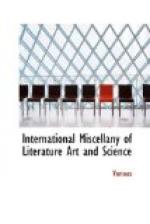* * * * *
[Illustration: Mrs. Fanny Kemble reading Shakspeare at the st. James’ theater.]
MRS. FANNY KEMBLE’S “READINGS” IN LONDON.
Mrs. Kemble has been giving a series of dramatic readings in London, and her success in the scene of her early triumphs appears to have been as decided as it was in New York. She was never in a situation more agreeable to her temper and ambition than that represented in the above engraving, which we have copied from one in The Illustrated News. She is triumphant, and “alone in her glory.”
Mrs. Kemble is now about forty years of age. Gentleness is acquired in three generations; she is removed but two from the most vulgar condition; and by the mother’s side but one. The Kembles of the last age were extraordinary persons. John Philip Kemble and Mrs. Siddons had both remarkable genius, and Charles Kemble has been an actor of consummate talent. Whatever intellect remains in the family is in his children; one of whom is a man of learning and refinement, another a woman of some cleverness in musical art, and Frances Anne, of whom we write more particularly.
The first appearance of Miss Kemble on the stage was on the evening of the 5th October, 1829, at Covent Garden, and was hazarded with the view of redeeming the fortunes of the theater. The play was “Romeo and Juliet,” and the heroine was sustained by the debutante with unexpected power. Her Siddonian countenance and expressive eyes were the general theme of admiration; while the tenderness and ardor of her action went to the soul of the spectator, and her well-instructed elocution satisfied the most critical ear. It was then, also, that her father took the part of “Mercutio,” for the first time. It is recorded that he earned by it thirteen rounds of applause. Nor was its merit overrated. It was then, and continued to be, a wonderful impersonation of the poetic-comic ideal. On the 21st of the




